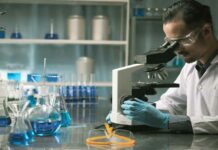In the course of the Green Technologies Day series, in April, LEWA once again invited experts to exchange thoughts and experiences, this time on the topic of energy efficiency – a competitive advantage in the process industry? The speakers and participants from the industrial and scientific worlds shed some light on current research activities and they discussed technologies that have been proven in practice. The look beyond one’s own nose at today’s business clearly showed: in any case, the system approach promises the greatest energy savings potential.
The question of whether energy efficiency is a competitive advantage in the process industry can be answered quickly in principle: of course it is an advantage to be able to produce with lower energy costs. Therefore, behind the topic selected for the second Green Technologies Day in April of this year by the patron lies an expanded question: How high is the true total energy savings potential? How can it be realised with the lowest costs? And is there previously unidentified savings potential?
Depending on how one grapples with the topic, the answer can vary a great deal.
A quick approach is to examine an individual component (pump, armature, heat exchanger, compressor) or a defined part of a system (compressed air supply, cooling water supply) and to optimise it. For many operators this is surely an important first step, as a study by the Fraunhofer Institute for Systems and Innovation Research (ISI) shows: according to this study, flow machines such as pumps, ventilators, and air compressors are among the especially ‘energy hungry’ components of a system.
It takes much more effort to regard a system as a whole and to optimise it as a system. However, this system approach offers the greatest energy savings as a reward. Last but not least, the operator profits in many cases from the additional bonus of more stable processes and product qualities.
Ionic liquids: still expensive, but very advantageous
The influence of grease liquidity may not be underestimated; specialists see additional optimisation potential with the use of ionic liquids. What are ionic liquids? Ionic liquids are salts built on cations and anions. Their particularity is a melting point below 100°C. All ionic liquids have an exceptionally low fugacity due to their salt-like character. The other physiochemical properties (for example; solubility behaviour, viscosity, electrical conductivity, stability) can vary widely depending on the type of ions.
Due to their special properties, ionic liquids open up many possibilities for optimising technical processes.
Two examples with a view of displacement pumps: with a test gear (medium gear size, spur-toothed, normal degree of efficiency at approximately 85% with gear oil), an increase in the degree of efficiency of approximately 4% could be measured. With a hydraulic diaphragm pump, a volumetric increase in the degree of effectiveness of up to 5% per 100 bar is possible – at 1,000 bar, this amounts to 40%. And this too is an advantage: ionic liquids release less air – they thus guarantee better suction and higher metering precision.
This has also been discussed: the increasing time pressure in the area of system planning makes it indispensable to order components such as pumps on the basis of more or less estimated parameters.
Urgent advice: as soon as there is better data, estimates and assumptions should be replaced by current values and the pump design should be checked. In addition, a system develops further and is driven later on by other operating points than at the time of its design. If deviations exceed particular limits, the design should be adapted.
Acceptance of longer amortisation times required
The initial question: Does energy efficiency offer a competitive advantage for the process industry? This can be answered clearly with a yes. And the advantage is clearer the more complete the systems and not just individual components are optimised.
The discussion brought an insight common to all industries: sustainable energy efficiency is not to be had for free. Investors must release the necessary financial means so that planners can also design and implement energy-efficiency systems for pumps with smaller output. The current amortisation times of two to three years accepted by the management of many companies are clearly too short.
Adapted ROI requirements are needed. And thus it becomes even clearer: the more complete systems and not just individual components are optimised, the more energy-efficiently a company can work.
Another insight: Anyone who offers energy-efficient systems earns 10% more in sales, but must invest 30% to 40% more effort in project work.
A pump manufacturer that sells an operator only individual pumps can clearly rejoice over better profits. However, whether he can be successful on the market in the long term with such a business model is doubtful.
Conclusion of the LEWA CEO for technology Dr Andreas Höhler, “The second Green Technologies Day showed once again: nothing can replace a personal conversation. Only the dialogue between operators and planners and not least with the world of science brings to light what is practically necessary and theoretically possible. It has also become clear to all of us: when it comes to the topic of ‘energy efficiency,’ it is worthwhile to look beyond one’s own nose.”




















